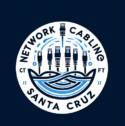What Is the Most Common Type of Network Cabling?
When setting up a reliable and fast internet connection, choosing the right network cable is one of the most important steps. Whether you’re wiring a business, a school, or your home, the type of cable you select determines how efficiently your network performs. So, what is the most common type of network cabling used today — and why? Let’s break it down. Our team of structured cabling professionals in Santa Cruz ensures every installation meets high performance and safety standards.
Understanding Network Cabling
Network cabling refers to the physical infrastructure that connects computers, servers, cameras, and other devices to a network. These cables carry data signals that allow information to flow between systems. While wireless networks are popular, wired cabling remains the foundation for stable, high-speed connections — especially in offices, data centers, and smart homes.
The Most Common Type of Network Cabling: CAT6
As of today, CAT6 (Category 6) Ethernet cable is the most common type of network cabling used in both residential and commercial installations. It’s part of the twisted-pair family of cables and is known for its balance of speed, affordability, and reliability.
CAT6 supports data transfer speeds of up to 10 Gbps over short distances (up to 55 meters) and 1 Gbps up to 100 meters, making it a great choice for modern internet usage, streaming, cloud computing, and business operations.
Why CAT6 Is So Popular
Here are some of the key reasons why CAT6 cabling is the industry standard for new network installations:
- High performance: Handles higher bandwidths with minimal interference.
- Future-ready: Compatible with gigabit and 10-gigabit networks.
- Affordable: Offers strong performance at a reasonable cost.
- Durable: Designed for long-term reliability and minimal maintenance.
- Widely available: Most networking equipment supports CAT6 cabling.
Because of its versatility, CAT6 is used in homes, offices, schools, healthcare facilities, and even industrial environments across California and beyond.
Other Common Types of Network Cabling
Although CAT6 leads the market, there are several other cable types used depending on network needs:
- CAT5e (Category 5e):
An older but still common option for basic networks. It supports speeds up to 1 Gbps but lacks the noise resistance of CAT6. - CAT6a (Category 6a):
A higher-performance version of CAT6, capable of maintaining 10-gigabit speeds up to 100 meters. Often used in large offices and data centers. - CAT7 and CAT8:
High-end cables used for specialized commercial or industrial networks that require extremely high bandwidth and shielding. - Fiber Optic Cables:
Used for long-distance and high-speed backbone connections. Fiber offers unmatched performance but is more expensive and requires professional installation.
Each type serves a specific purpose — and the right choice depends on your building’s size, network demands, and budget. Before identifying the most common types, it’s helpful to understand the primary purpose of network cabling.
CAT6 vs. Fiber: Which Is Better?
A common question people ask is whether fiber optic cabling is better than CAT6. The answer depends on your needs.
- CAT6 is more affordable and ideal for shorter runs, such as within a home or small office.
- Fiber optic is better for large commercial buildings or campuses where you need to transmit data over long distances with zero signal loss.
In many modern setups, both technologies are used together — fiber for backbone connections and CAT6 for local runs to workstations or devices.
Choosing the Right Network Cabling for Your Needs
When selecting a cable type, consider:
- Speed requirements: Gigabit or 10-Gigabit network?
- Distance: Longer runs may require fiber.
- Environment: Industrial or outdoor settings need extra protection.
- Budget: CAT6 offers excellent value for most applications.
- Future expansion: Installing higher-category cables now can save upgrade costs later.
A professional structured cabling installer can assess your space, run the proper tests, and recommend the best type of cabling for your setup.
The Bottom Line
The most common type of network cabling today is CAT6 Ethernet cable — and for good reason. It’s reliable, fast, and cost-effective, making it ideal for both homes and businesses. Whether you’re setting up a small office or upgrading a large facility, CAT6 cabling gives you a network that performs well today and can handle future demands. Once you’ve chosen the right cable type, make sure to review the most important factors to consider when installing network cabling.
If you’re planning a new installation or upgrade, contact your local network cabling experts to design a structured system that delivers the speed and stability you need.
